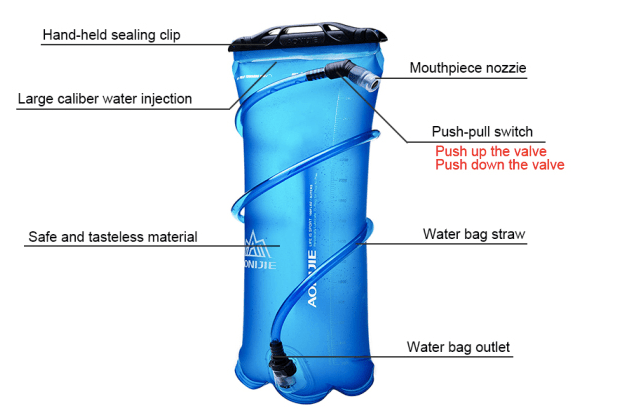
BY: ALISON
Staying hydrated is important for maintaining one’s wellbeing. It is even more important for those who are recovering from any sort of health issue, surgery or treatment. In the extreme heat of the summer, and staying hydrated is an even bigger priority.
Unfortunately, simple every day tasks such as getting water are extremely difficult for people struggling with pain, fatigue, brain injury, or disability. Depending on a person’s health, independently replenishing your water every few hours can be impossible.
For weeks after my concussion, when my then boyfriend brought cups of water to me, I wasn’t able to lift my head off the bed to drink it. The use of a straw allows you to drink without lifting your head, but you still have to reach for and hold a cup awkwardly or wait for assistance. Neither of which are ideal nor necessarily feasible.
Here is the best solution that I know of for staying hydrated.
Essential Tool for Hydration
I highly recommend Cycling Water Bags. These are also called: Water Bladders, Hydration Bladders, or Reservoirs.
The important thing is that they are made up of the following main components:
- A lightweight, leakproof, plastic bag that contains the water
- A long plastic tube
- A mouth piece, valve or nozzle – some nozzles come with a built-in dust cover, which is great – but I just cover the mouth piece very loosely with a plastic sandwich bag
- A mechanism to close off the nozzle to prevent water leakage when not in use
Place the water bag next to you, whether you’re sitting in a chair or laying in bed, with the water bag outlet (where the tube connects to the water bag) facing down. You can also hang the water bag up near you (with the water bag outlet at the bottom).
The tubing is light weight, flexible and long enough to allow for easy access from any position. Place the nozzle very close to your head or within reach of your hands. To take a sip of water, bring the nozzle to your mouth, bite on the silicone part, and then suck the water out from the water bag through the tubing.
If you aren’t able to bite on the nozzle (for example, due to lock jaw) or if the pressure required to suck up the fluids exacerbates your symptoms, simply hang the water bag above your head level and then use your fingers to squeeze the nozzle; fluid will still flow out.
Notes:
The water bags should only be used to hold water (e.g. no lemon, Gatorade, flavoured or vitamin waters, etc.).
All of the pieces should be disassembled and washed once a day (ideally) or, at the very least, once every two days. They also need to be hung to dry completely before being stored away.
Choosing a Cycling Water Bag
Here are a few things to consider when selecting the right water bag for you.
Sealing Mechanism:
The opening of the water bag is either closed with a screw-on lid or a slide-across seal. Personally, I prefer the screw cap, but some people might find the slide seal easier to use. You can test them out in the store. I purchased mine from MEC though there are other options as well – do a Google search for ‘Water Bladder Toronto’ (or where you live) – to find out purchasing options.
Size:
One of the advantages of using a water bag is not having to refill your water source as frequently. And you can get large water bags that hold several litres of water. But consider the pros and cons of using a larger water bag. For example, a larger water bag will take up more space and will be heavier to carry around. I chose a two litre (i.e. eight cups) cycling water bag and it works very well for me.
I also chose a bag that shows the levels of water volume so I can easily track how much water I’ve consumed throughout the day. It also serves as a visual reminder to drink enough water every day.
Accessories:
You might want to consider purchasing cleaning accessories for your cycling water bag. If you’re very active, there are backpacks that are designed just for carrying the water bags. These are great for outings, long walks, hiking, cycling, etc.
‘Mind Yourself with Alison’ is a collection of self-help tips, research, and personal experiences dedicated to helping people thrive after brain injury (or other health problems). Check out Alison’s other BIST Blog articles Women and Brain Injury: What you need to know and How to be a Good Friend to a Survivor. You can follow her on Twitter, HERE.




